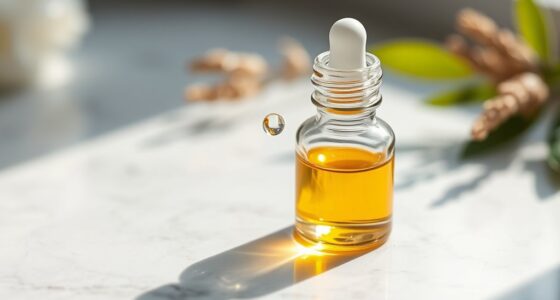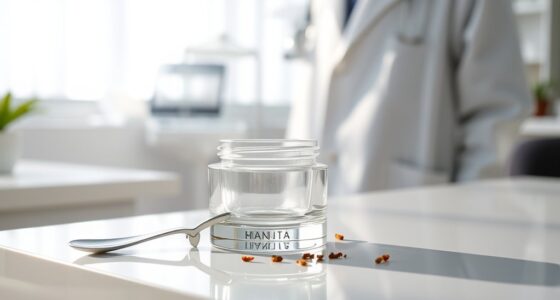To choose the right luxury chemical exfoliant, consider your skin type and concerns. If you want to improve dullness, surface texture, or hyperpigmentation, an AHA works best by exfoliating surface layers. For deeper pore cleansing, oil control, or acne, a BHA like salicylic acid penetrates pores. Ensuring proper use, sun protection, and selecting gentle formulas help maximize benefits while minimizing irritation. Keep exploring to find the perfect match for your skincare goals.
Key Takeaways
- Choose AHAs for surface exfoliation to improve dullness, uneven skin tone, and fine lines.
- Opt for BHAs if you have oily, acne-prone skin needing deep pore cleansing and oil control.
- Consider skin sensitivity; gentle acids like PHAs or lower concentrations suit sensitive skin best.
- Use AHAs in dry, sun-damaged areas; apply BHAs to congested, oily zones for targeted treatment.
- Always follow with SPF and introduce acids gradually to maximize benefits and minimize irritation.
Understanding the Core Differences Between AHAs and BHAs
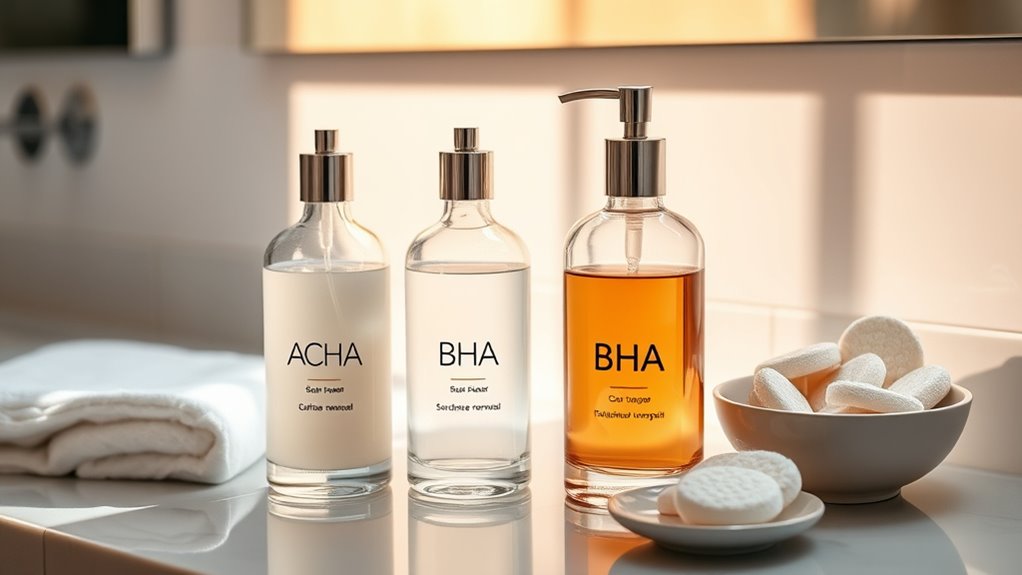
To choose the right exfoliant, it’s essential to understand the core differences between AHAs and BHAs. AHAs are water-soluble acids derived from fruits and sugars, primarily targeting exfoliation on the skin surface. They work by dissolving the bonds between dead skin cells, improving skin texture and tone. BHAs, like salicylic acid, are oil-soluble acids that penetrate deeper into pores for pore cleansing and excess sebum removal. This makes BHAs especially effective for acne-prone skin. The key difference lies in their solubility: AHAs affect surface layers, while BHAs target deeper pore issues. Knowing this helps you choose an exfoliant suitable for your skin care routine, whether you need surface renewal or deeper pore cleansing. Understanding skin permeability can further optimize your exfoliation choices. Additionally, considering your skin type and specific concerns can lead to more tailored and effective exfoliation. Recognizing the composition of ingredients in exfoliants can also help you select products that best suit your skin’s needs. Furthermore, understanding how skin sensitivity influences your reaction to these acids can prevent irritation and improve results.
Which Exfoliant Suits Your Skin Type and Concerns

Choosing the right exfoliant depends on your skin type and concerns. If you have dry, sun-damaged, or dull skin, AHAs are ideal for surface exfoliation, boosting radiance and skin benefits. For oily, acne-prone, or congested skin, BHAs penetrate pores deeply to dissolve excess sebum and dead cells, promoting oil control and clearer skin. Sensitive skin benefits from gentler acids like PHAs or lower concentrations of AHAs and BHAs, reducing irritation while still encouraging exfoliation.
If you have combination skin, consider targeting different areas—using AHAs on dry zones and BHAs on oily regions for balanced exfoliation. Always choose an exfoliant that aligns with your specific skin concerns, whether it’s hyperpigmentation, fine lines, or excess oil, to achieve ideal results. Incorporating mindful decluttering strategies when selecting skincare products can help you make better choices and avoid unnecessary accumulation of unused items. Understanding the different types of acids used in exfoliants can further help you select the most effective option for your skin. For example, learning about acid strengths and formulations can assist in customizing your routine for optimal benefits. When using glycolic acid, especially in products like toners or body washes, it’s beneficial to consider its benefits for skin to maximize your skincare routine effectively. Additionally, being aware of the offensive and defensive roles in cybersecurity can help you understand how different acids work to improve skin health.
How to Incorporate AHAs and BHAs Into Your Skincare Routine
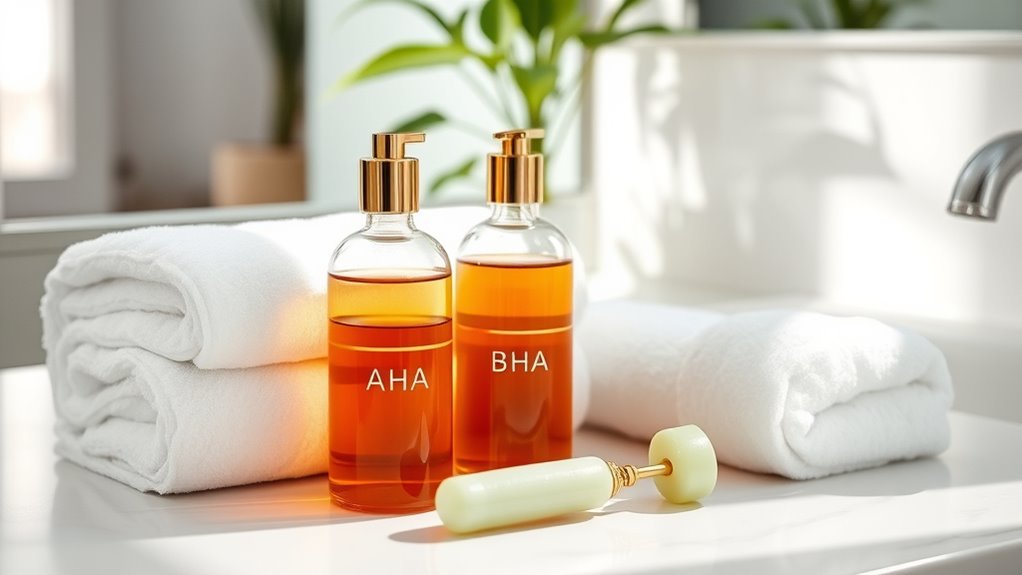
Incorporating AHAs and BHAs into your skincare routine requires careful planning to maximize their benefits while minimizing irritation. Start with low concentrations of exfoliating acids, around 5-10%, and apply them after cleansing and toning in your evening routine. Wait a few minutes for absorption before moisturizing. Begin with two to three times per week and gradually increase application frequency based on your skin’s response. Monitor your skin tolerance closely to avoid over-exfoliating. Use chemical exfoliants alongside hydrating ingredients like hyaluronic acid and protective sunscreen daily, especially since acids can increase sun sensitivity. Incorporating air quality considerations, such as using an air purifier, can also help create a healthier environment for your skin. Recognizing the importance of attention in skincare can enhance your ability to notice subtle changes and adjust your routine accordingly. Maintaining a consistent skincare routine helps optimize results and reduce the risk of irritation. Regular use, paired with proper hydration and sun protection, helps improve skin texture, prevent acne, and enhance overall skin health. Additionally, understanding your skin type can guide you in choosing the most suitable acids for your needs, ensuring better results and fewer side effects.
Tips for Safe Use and Maximizing Benefits of Chemical Exfoliants
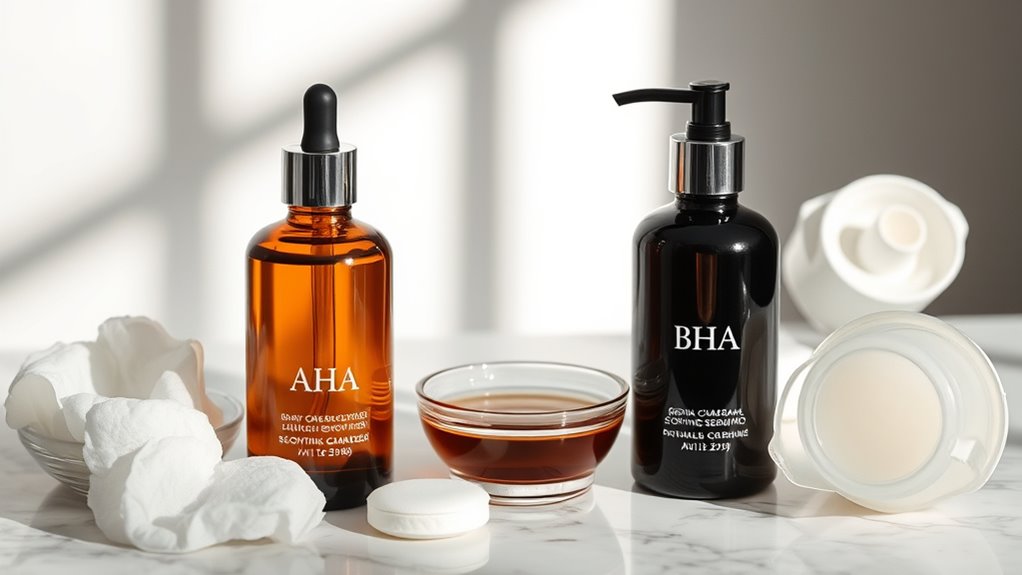
Starting with a patch test is essential before fully integrating chemical exfoliants into your routine, as it helps determine your skin’s tolerance and prevents potential irritation. To maximize benefits and stay safe, pay close attention to your skin’s response. Using a low-cost electric bike can be an excellent way to incorporate sustainable transportation into your routine while minimizing environmental impact. – Use a low concentration (around 10%) and gradually increase frequency, like every other night, to avoid over-exfoliation and damage to your skin barrier. – Always apply broad-spectrum SPF 30 or higher daily, especially when using AHAs or BHAs, since they increase photosensitivity. – Avoid combining multiple acids or active ingredients at once, which can lead to irritation and compromise your skin’s health. Monitoring your skin’s reaction and adjusting your routine accordingly will help you achieve a smoother, healthier complexion without irritation.
Navigating Common Challenges and Precautions With AHA and BHA Use
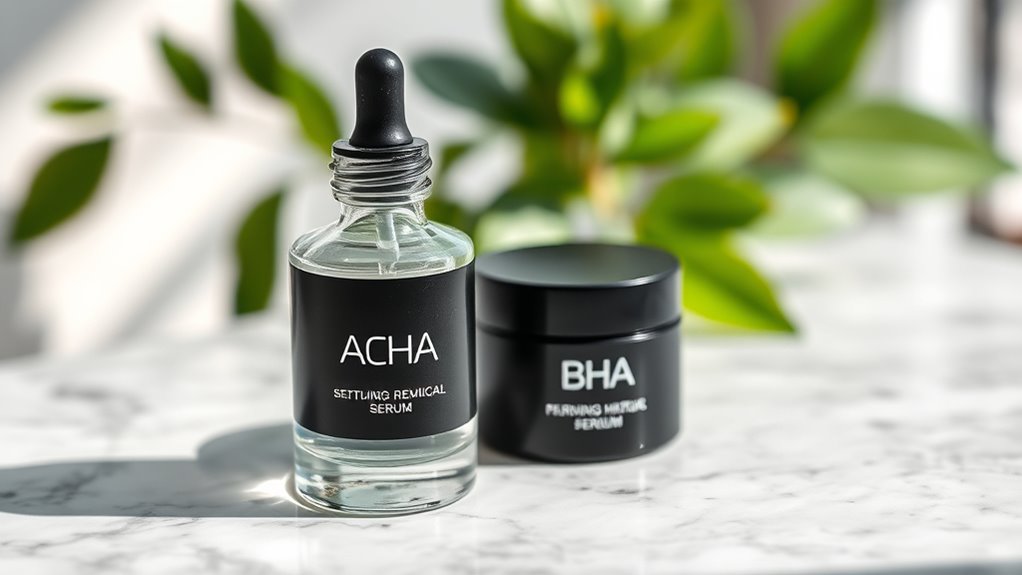
While AHAs and BHAs can transform your skin, they also pose challenges if not used carefully. Over-exfoliation can weaken your skin barrier, causing irritation, sensitivity, and redness. Using high concentrations or applying acids too often hampers skin adaptation, leading to dryness and peeling. Combining multiple exfoliants or active ingredients like retinoids without precautions increases the risk of burning or inflammation. Plus, neglecting sun protection amplifies UV damage and hyperpigmentation. To avoid these issues, introduce acids gradually, monitor your skin response, and respect your skin’s limits. Incorporating protective styling techniques with your skincare routine can also help minimize irritation. This approach aligns with the importance of skin health and the need for proper exfoliation practices. Understanding the role of AI in media and entertainment can also inspire innovative skincare marketing and educational content. Additionally, being aware of seasonal variations can help tailor your exfoliation routine to different weather conditions. Regularly using glycolic acid products can enhance skin texture and radiance when introduced thoughtfully. Here’s a quick guide:
| Challenge | Precaution |
|---|---|
| Over-exfoliation | Limit frequency and concentration |
| Skin barrier damage | Use gentle formulations |
| Irritation & sensitivity | Patch test first |
| Sun sensitivity | Apply broad-spectrum sunscreen |
| Active ingredient combo | Space out different actives |
Frequently Asked Questions
How Do I Know if I Should Use AHA or BHA?
If you’re wondering whether to use AHA or BHA, consider your skin concerns. For uneven tone, dullness, or fine lines, choose an AHA to exfoliate surface layers and boost collagen. If you’re prone to acne, blackheads, or enlarged pores, BHA works better by penetrating deep and clearing out pores. Also, match your choice to your skin type—sensitive or dry skin might prefer gentle AHAs, while oily or acne-prone skin benefits from BHAs.
Should I Exfoliate With AHA or BHA?
Imagine your skin as a canvas, waiting for a gentle sweep to reveal its radiance. If you want to brighten dullness, smooth fine lines, or even out tone, AHA is your brush, softly exfoliating surface layers. But if blackheads, excess oil, or acne are your concern, BHA dives deep, clearing pores like a skilled artist. Choose based on your skin’s needs—gentle surface refresh or deep pore cleanse.
What Percentage of AHA and BHA Should I Use?
You should start with about 5% AHA if you want gentle exfoliation, increasing to 10-12% as your skin tolerates. For BHA, 1-2% is usually effective, but beginners should begin with 0.5-1% to minimize irritation. Always follow product instructions, introduce acids gradually, and wear sunscreen, especially with higher concentrations, to protect your skin from sun sensitivity. Adjust percentages based on your skin’s response.
Can I Switch Between AHA and BHA?
You can switch between AHA and BHA if your skin tolerates both, but do it gradually. Start with one, observe how your skin reacts over a few weeks, then introduce the other slowly. Use them on different days to prevent irritation and protect your skin barrier. If your skin is sensitive or compromised, consult a dermatologist before making changes to avoid adverse reactions.
Conclusion
Choosing between AHAs and BHAs is like picking the right brush for your canvas—each brings a unique glow to your skin’s masterpiece. With the right exfoliant, you’ll reveal a radiant, smoother complexion that feels as fresh as morning dew. Trust your skin’s signals, follow safety tips, and enjoy the journey toward luminous, healthy skin. Your perfect glow awaits—just like a sunrise, it’s worth the gentle, mindful touch.


